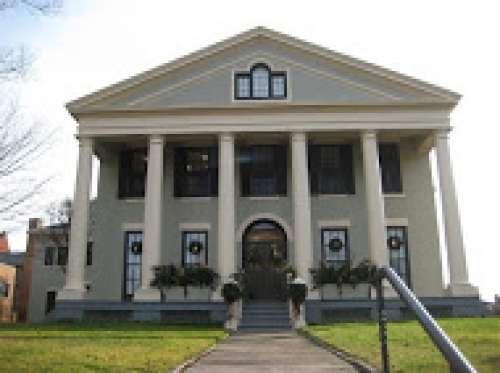

 The Life of Theodore Roosevelt
The Life of Theodore Roosevelt
 The History of the House
The History of the House
 The Inauguration
The Inauguration
 The Pan-American Exposition
The Pan-American Exposition
 Contemporary Historical Figures
Contemporary Historical Figures

An army barracks, a private residence, the place where one of the most significant events in our nation's history took place, a restaurant, an abandoned building, a National Park Service site. Explore the fascinating history of 641 Delaware Avenue in Buffalo, N.Y.
In 1837, concerned about a minor insurrection in Canada known as the Patriot's War, the citizens of Buffalo demanded that the United States government provide for their protection in the event of an attack. Many people vividly remembered when their village had been nearly burned to the ground by the British during the War of 1812. In response to the residents’ plea, the federal government leased the highest ground within the city limits and established an Army post. It was located within the square block area bounded by Delaware Avenue, Main, North, and Allen Streets. The new post was called the Buffalo or Poinsett Barracks. (Joel Poinsett was the Secretary of War from 1837 to 1841 and is perhaps better known for giving his name to a popular holiday plant, the poinsettia.) Built between 1838-40, the Buffalo Barracks became the largest United States military installation at that time. At its height, the Barracks housed over six hundred men as well as several wives and children. The home that is now the Theodore Roosevelt Inaugural National Historic Site was originally built as officers' quarters located along Delaware Avenue, but facing the parade ground and Main Street.
As the military threat from Canada waned, officers and soldiers were able to take advantage of the city and its amenities. The Barracks became the center of social life in Buffalo in the early 1840s. Numerous parties, balls and weddings were held on its grounds. One woman remembered that many of Buffalo’s most prominent young ladies (including three of her sisters) were “carried off” by officers from the Barracks. On a more serious note, the Buffalo Barracks also became a proving ground for young soldiers and officers. Many left Buffalo to fight in the Mexican War and later achieved fame as high ranking officers in the Union and Confederate armies during the Civil War.
Lasting peace and growth within the city diminished the need for the Buffalo Barracks. By 1846, the Barracks were abandoned and many of the buildings dismantled. The land reverted back to its owner and the remaining structures were adapted for other uses. The officers’ quarters, for example, became a private home.
The property once occupied by the Buffalo Barracks was subdivided and sold in the mid-1840s. The neighborhood was further changed by the extension of Franklin and North Pearl Streets through the former parade ground. Meanwhile, ownership of the double-house that had served as senior officers’ quarters passed through the hands of several locally prominent men, who transformed it into a single family residence.
Former Buffalo mayor Joseph Masten purchased the property in 1847. He lived there with his family for ten years, during which time the house faced Franklin Street and was known as “Chestnut Lawn.”
Attorney Albert P. Laning, who served in both the New York State Assembly and Senate, purchased the house in 1863. A few years later, the city directory began listing the residence on Delaware, instead of Franklin. A large, brick carriage house was also added to the property, likely while the Laning family lived in the home. Shortly after Laning’s death in 1880, the house was once again sold.
In 1883, Dexter Rumsey purchased the house as a wedding gift for his daughter, Mary Grace, upon her marriage to Ansley Wilcox, a young Buffalo lawyer. The Wilcox family made 641 Delaware Avenue their home from 1883 to 1933. When they moved in, the home was made up of the old officers’ quarters and a small service wing on the back of the house. Minor changes were made in the 1880s and after knocking down the service wing, a much larger addition was attached to the back of the house in 1896. The change more than doubled the size of the residence.
Ansley Wilcox and his wife died in the early 1930s, leaving the house vacant. After family members removed the items they wanted to keep, the remainder of the furnishings were sold at auction in 1935. Not long after the auction, a campaign led by veterans of the Spanish American War sought to establish the house as the "Theodore Roosevelt Institute for Better Citizenship." This effort failed and there was talk of tearing the house down.
In 1938, the former Wilcox house was leased to Oliver and Kathryn Lawrence for use as a restaurant. The Lawrences extensively remodeled the house, removing many walls and architectural features, including the main interior staircase. The carriage house was also torn down to make room for customer parking. Using a presidential theme, the Lawrences displayed flags and hung pictures of Theodore Roosevelt throughout the dining rooms. A plaque, in what had been the library, told the story of the inauguration. A star was placed on the ceiling above the location where Roosevelt stood during the 1901 ceremony. On the second floor, what had been four bedrooms and a hallway was converted in to a large banquet space. For more than twenty years Kathryn Lawrence’s Dining Rooms ranked among the most popular restaurants and banquet facilities in Buffalo.
By 1961, a changing society, a shift from residential to commercial properties on Delaware Avenue, and the death of Kathryn Lawrence forced the restaurant to close. Once again the house was abandoned and threatened with demolition.
In the early 1960s, the house stood vacant and was vandalized numerous times. A movement began in 1963 to save the house from the wrecker’s ball. Community organizations such as the Junior League of Buffalo worked with the Buffalo and Erie County Historical Society (now the Buffalo History Museum), local businesses and individuals in this effort. Rallies and clean-up drives were held to draw attention to the situation. Meanwhile, in Congress, legislation was proposed by Representative Thaddeus Dulski (D-NY) to declare the house a National Historic Site. With the legislation pending and the house at risk of demolition, Liberty National Bank stepped forward and bought the property. The bank agreed to hold it until federal monies could be secured. Finally, in November 1966, legislation was passed granting the house status as a National Historic Site and allocating funds for its purchase and restoration.
Using photographs from the early 1900s, original architectural drawings, recollections of Wilcox family members and friends, as well as other evidence, restoration work formally began in 1969. Original architectural features were reconstructed and Wilcox furnishings were returned.
On the seventieth anniversary of Theodore Roosevelt’s inauguration, September 14, 1971, the Theodore Roosevelt Inaugural National Historic Site opened its doors to the public.
After opening in 1971, the Theodore Roosevelt Inaugural Site enjoyed thirty-five years of growth and success. In order to attain its fullest potential, however, the TR Site needed to expand. A comprehensive feasibility study was conducted, alternatives were weighed, and—with the support of the National Park Service—the Theodore Roosevelt Inaugural Site Foundation resolved to build an addition on the site of the carriage house that had been torn down in the late 1930s.
The $2.7 million project not only expanded the TR Site’s physical presence, but also incorporated many improvements and upgrades to the original structure. Among the project’s lasting accomplishments are: universal access; an expanded admissions area; a new museum shop; a large education/event space; new artifact storage space; installation of fire suppression and air conditioning systems; interior and exterior painting; electrical upgrades; as well as wood, masonry, roof and gutter repairs.
While the construction and renovation was taking place, the TR Site staff was working behind the scenes with museum consultants, historians, and exhibit designers to completely reinvent the museum’s tour and exhibits. In June of 2009, the Theodore Roosevelt Inaugural Site Foundation unveiled an entirely new visitor experience, featuring a multi-dimensional series of interactive approaches that invites visitors to appreciate the site of Roosevelt’s 1901 inauguration as a dynamic tour through time.
The landscape around 641 Delaware Avenue was transformed in the century following TR’s 1901 inauguration. Among other changes, a two-story, modern glass and concrete bank building replaced what had once been a gracefully sloping lawn on the south side of the Wilcox home. When the bank opened its doors on March 28, 1960, its northern wall stood less than fifteen feet from the room where Theodore Roosevelt was sworn in as president. For more than forty years, the building was an overwhelming presence that distracted from the historic setting.
In November of 2010, however, the owners of the bank building approached the TR Site with an offer to donate the building and property. After the transfer was complete, the Foundation’s generous supporters contributed nearly $1 million, enabling the TR Site to demolish the bank building while expanding and redesigning the parking lot.
Overall, the project reclaimed green space, improved access to the TR Site, and enhanced its visibility from Delaware Avenue. In that the property has also been restored to its 1901 configuration, the project promotes deeper historical understanding. Visitors and passersby are now able to enjoy a better sense of the setting that greeted Theodore Roosevelt as he arrived in Buffalo to begin his presidency on that fateful fall day.

The Theodore Roosevelt Inaugural National Historic Site is operated by the Theodore Roosevelt Inaugural Site Foundation, a registered non-profit organization, through a cooperative agreement with the National Park Service.
© 2025 | All Rights Reserved
641 Delaware Avenue, Buffalo, NY 14202 • (716) 884-0095
Website by Luminus
